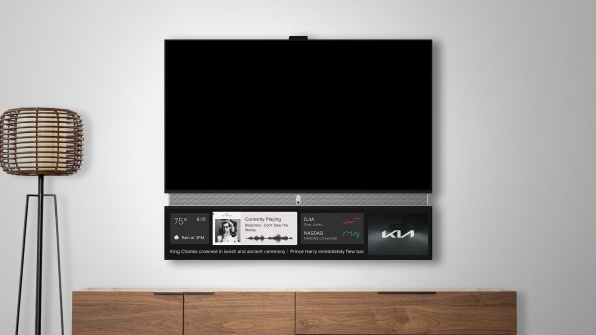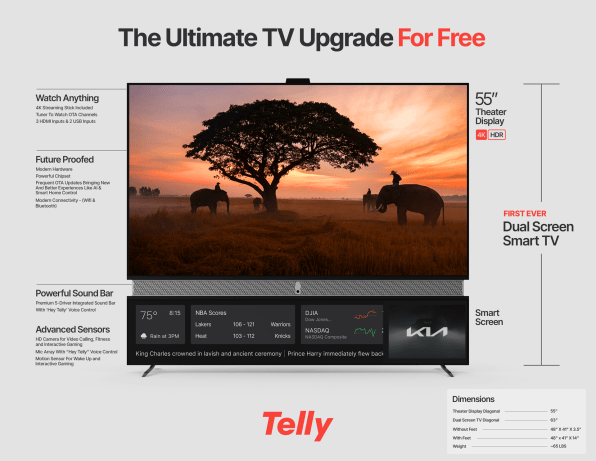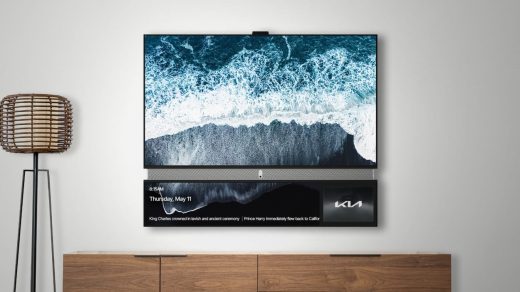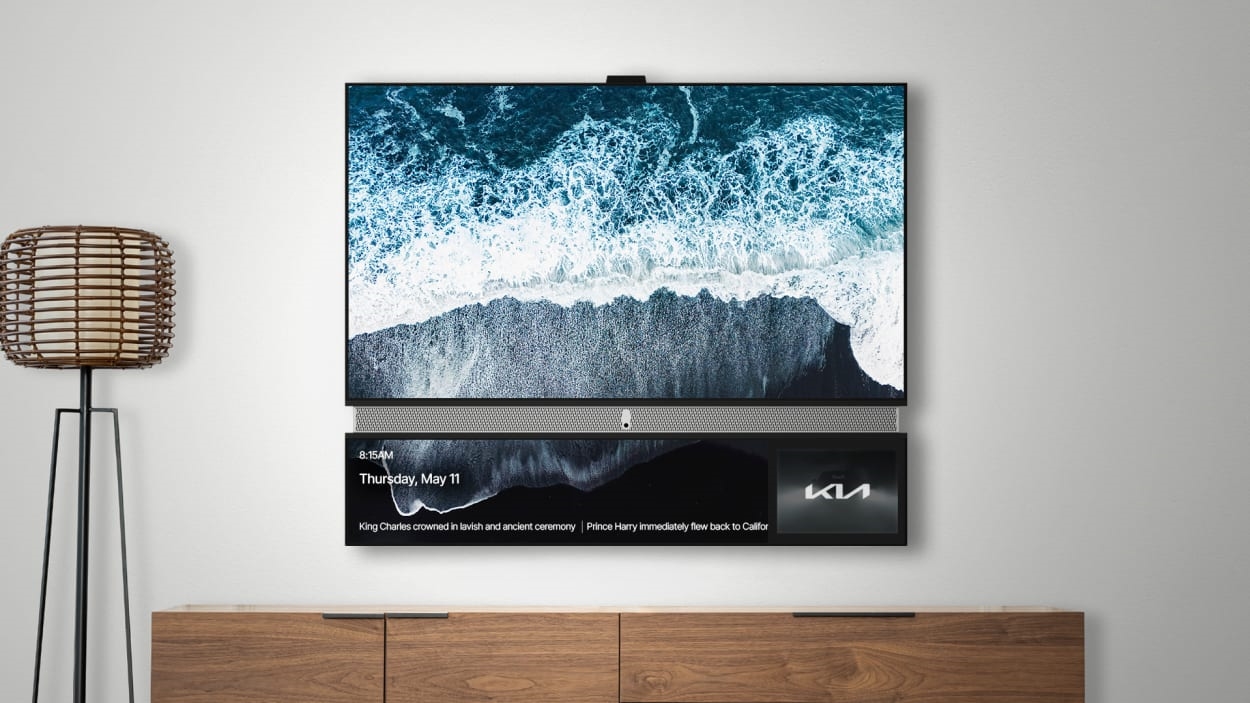Telly’s wild idea: Free TVs with inescapable ads
Would you take a free TV if it constantly ran banner ads beneath everything you watched?
That‘s the proposition for Telly, one of the most intriguing and unusual hardware startups in recent memory. Telly has designed a 55-inch 4K HDR TV with a built-in soundbar and a second screen mounted underneath. On that extra screen, users will see a mix of informational widgets and advertisements, which can’t be disabled. Janko Roettgers broke the news of Telly’s existence earlier this month, but now the startup is making it official.
“We’re giving the device away for free, and the entire business model is supported by our advertising, data, and affiliate revenue streams,” says Telly founder and CEO Ilya Pozin, who previously cofounded the free streaming service Pluto TV.
Telly plans to ship out 500,000 free TVs in 2023, and is opening up a waitlist today. While the idea might seem outlandish, it’s really just taking the smart TV business model to its logical end. TV makers already sell their hardware at slim margins while relying on revenue from targeted ads and data brokering to boost profits. By inventing a new kind of TV around that model, Telly believes it can eat the entire hardware cost and still come out ahead.
Not your typical smart TV
Telly’s bottom screen isn’t just a vessel for ads. In demos and product images, the ads cover roughly a quarter of the bottom screen, with the rest being used for information and interactive features. You might use it to glance at the weather or a news ticker, for instance, or to quickly control music playback.
The bottom panel also stays lit up when movies or TV shows are playing, albeit at a lower brightness than when you’re browsing around. That’s a non-negotiable part of the deal, though Telly hopes you’ll want access to the bottom screen more often than not.
“Even when your main screen is off, you can leave the bottom screen on, and it becomes the main device in your home,” Pozin says. “We believe that’s what a TV in 2023 should be.”

Oddly enough, Telly isn’t building any actual smart TV software into the television. Instead, Telly will ship with an Android TV streaming dongle, which users can plug into any of the TV’s three HDMI inputs. Telly’s own Android-based OS will only control the TV’s ads and interactive features.
Alongside the extra screen and built-in soundbar, Telly’s TV also includes a camera and microphone. These will allow for video chat on either screen—Zoom is an initial partner—along with “Hey Telly” voice commands.

Telly has a lot of other ideas for the second screen. Pozin mentions smart home controls and security camera footage as examples—though Telly has no partnerships yet on these fronts—and it’s also working on a software development kit for app makers. The plan is to constantly upgrade the TV’s capabilities over time.
“Don’t be fooled by the fact that it’s free,” Pozin says. “What we’re building here at Telly is by far the most feature-rich smart TV on the market.”
What about privacy?
Implicit in the free TV concept is that you’re surrendering some data privacy in return. The waitlist signup alone requires a five-minute survey with a gamut of questions about your personal life. Telly says it will use this information to decide who gets a TV in the first place and to fuel its ad targeting efforts.
“We know where you live, what your income bracket is—obviously it’s all anonymized—but we know what car you’re driving. We know when your lease is up. We know where you shop. We know what your favorite sports teams are, et cetera,” Pozin says. Auto makers can then use that information to target people whose leases are coming due, while food delivery companies could show ads around dinnertime to people who often order in.
Like many other smart TVs, Telly will also detect what’s playing on the TV with automatic content recognition (or ACR), which it may sell in anonymized form or use for targeted ads. The difference with Telly is that you can’t opt out of this data collection. At best, you can ask Telly not to sell your data in states where that’s an option.
Perhaps that’s a bit out of tune with an increasingly privacy-aware society, but it’s not as if Telly is hiding the nature of its business.
“We’re very up-front and transparent,” Pozin says. “Everyone knows what they’re getting into, what the value exchange is.”
Is Telly for real?
Telly has already shipped a small number of TVs for private beta testing, and aims to start fulfilling waitlist orders this summer. Its goal is to ship 500,000 sets by the end of the year.
Whether it can actually do that deserves a bit of skepticism. Data from IHS Markit shows that a 55-inch LCD TV costs about $200 to make, while Pozin says Telly’s TVs would be worth about $1,000 if the company wasn’t giving them away. Even assuming $200 per unit—unlikely, given the built-in soundbar, extra screen, and entirely new design—Telly would have to spend $100 million to produce this year’s batch alone.
The company won’t confirm whether it has the cash on hand to do so. While Telly has named LightShed Ventures as a lead investor and Gary Vaynerchuk’s Vayner Media as an early launch partner, it’s not disclosing how much money it’s raised. Those who sign up for Telly’s waitlist could hand over a bunch of personal information, only to get nothing in return.
That said, Telly isn’t just some inexperienced team running an overly ambitious Kickstarter campaign. The company has hired from across the TV and tech industries to build out its product, and Pozin himself is well aware of the allure of free stuff. Prior to founding Telly, Pozin was the co-founder of Pluto TV, which paved the way for free, ad-supported streaming services and was acquired by Viacom (now Paramount) in 2019.
“If you recall, back then, everyone thought we were completely nuts, because we were launching a linear, ad-supported service where everyone was going subscription on-demand,” Pozin says.
Now, many TV makers now pre-load their TVs with free, ad-supported streaming services—Pluto TV among them—and use the ad revenue to pad out their slim hardware margins. Pozin’s new vision is clearly more ambitious, and a bit more unnerving, but the more you think about it, the less crazy it seems.
Sign up for Jared’s Cord Cutter Weekly newsletter for more updates from the streaming TV world.
(9)



